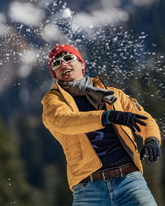Tracing Kieren DSouza’s Triple Trouble Run
There are very few people in India who experience life the way Kieren D'Souza does. While most of us are content with existing in the mundane, never-ending loop of city life, Kieren is an Indian athlete who has taken the phrase "run to the mountains" very seriously. Infact, he is one of the very few athletes in India who prefers running on the long and coarse(and at times, hostile) trekking routes of the Himalayas than the conventional racing tracks. If you ask him why he does that, he will tell you that these runs are not just about challenging yourself but also about trying something new in the mountains-something that is not popular or even thought of in this part of the world.
It comes as no surprise that he wants to be the pioneer of adventure sports like these in India, and till date, he has completed numerous successful runs on some of the most difficult trekking routes and to some of the highest mountain passes in record time. His passion and zeal to accomplish seemingly impossible feats make him a role model for the next generation of athletes and his marathons on difficult mountain terrain speak volumes of his determination and confidence to scale all odds that life and nature throw at him!
We were fortunate enough to interview him about his latest run, the Triple Trouble marathon which he accomplished only a week back, thus reminding his countrymen that nothing is impossible, however improbable it seems, even in these unprecedented times.
Triple troubles and other risks
When you are running across tricky trekking routes in the pitch darkness of the night(or even in daylight) with no support and network connectivity available, there is surely a considerable amount of risk involved. Probably, this is why we are discouraged to try such stunts, and if you are a person who cares little about adventure treks, you might not even want to travel to these places, unless you are on a 4 wheeler maybe!
For Kieren though, his level of acceptable risk is on a different level altogether compared to the layman, and this is not only a byproduct of his wanderlust and steely determination but also his confidence in his own training and fitness. The fact that he has been living in Manali for the last 6 years and has a lot of experience on these hilly terrains probably gives him an edge as well. He opines that fitness is an important factor in pulling these stunts off and believes that proper training can get us both physically fit and mentally strong to access the mountains in a much faster way.

Kieren's level of acceptable risk while running on the majestic mountains is significantly different from his fellow countrymen. Image of Kieren running in Manali by Abhijeet Singh.
His latest marathon called the Triple Trouble Run started from Manali Mall Road at the dead of the night and ended in the same place 19 hours later (exact time: 18 hours 55 minutes) after he had covered two 4000m passes on barefoot! He mentions how this route, which once used to be an important trading route between Manali and Lahore, had been on his checklist for a long time and the fact that he could cover the entire 126km long route including the Rohtang pass in under a day, made his efforts worthwhile.
Now, before we delve into more details about this amazing run, let's understand how athletes like Kieren prepare themselves before taking on these mammoth challenges.
The ideal gear for long runs
When you are running in the cold, your body generates a lot of heat and hence you start feeling warm and uncomfortable in heavy clothing. You also start sweating a great deal, hence you need attire with good moisture-wicking properties. When we asked Kieren what he wears while running in winter or in extreme cold climates, he mentioned that merino wool thermals and shorts are enough to keep him warm and comfortable.
It's recommended to not wear multiple layers of winter wear to prevent overheating but rather focus on accessories like hand gloves and winter socks for trekking. Finally, it's important to remember that as you'll be running fast, you do not need to rely on heavy clothing and also should avoid carrying a heavy backpack.
 Everything Kieren needs to carry before his long marathons on the mountains. | A picture of Kieren training in the shadows by Prashant Bhatt.
Everything Kieren needs to carry before his long marathons on the mountains. | A picture of Kieren training in the shadows by Prashant Bhatt.
"I usually run without wearing my t- shirt in low altitudes and usually carry lightweight thermals along with an extra pair of gloves in my pack for the higher altitudes and passes"- says Kieren
The triple trouble marathon
Manali mall road witnessed this athlete taking on yet another stiff challenge in the middle of the night last week. His plan was to run the Hampta Trek to Chattru, from there move up to the Rohtang Pass, and then back via the same route to Manali mall road. He covered this 126km route( with the highest elevation of 4270m in Rohtang) which sounds difficult even on paper, in just 18 and a half hours, becoming the first Indian to do so in the process.

A silhouette of Kieren against the mighty mountains by Kshitij Gupta | The route of the Triple Trouble Run[/caption]
The first part of the run was probably the most challenging aspect for Kieren as he had to run in complete darkness through the tricky trekking route of Hampta without any support or network connectivity. In his own words, "I had to be well aware of where I was running and my surroundings because you don't want to run into a bear in the middle of the night."
He also mentions how he took the wrong trail while coming down, didn't cross the river, and was on the left bank all by himself and nowhere to go or ask for support. He admits that those were the trickiest few moments of his whole marathon. But all of this was worth the efforts when he reached the exquisite Rohtang pass and finally ran 50km back to Manali mall road, tired and exhausted from his 18-hour long marathon.
Importance of eco-friendly mountaineers
Over the years, numerous tourists have littered the beautiful peaks with food wrappers, plastic bottles and these wastes have had a huge negative impact on the ecosystem. The mountains, he says are for everyone to enjoy, and the waste we generate as trekkers, runners, or tourists has to be collected and dumped somewhere else, which without proper waste treatment, would lead to severe environmental degradation.
Kieren DSouza in his blog about his Friendship peak run mentions his role as an eco-conscious trail runner: "The team on the mountain was provided packed food by the chef at the 4Play office, Ram Singh. All garbage generated by the team, including packets of instant noodles were brought back to the road-head; along with the pieces of plastic that were found while hiking."
Apart from this, we should also focus on selecting eco-conscious clothing for our winter wardrobe or while venturing out for our winter treks/runs and avoid synthetic fabrics that can harm nature or using leather made out of animal skin.

Kieren makes sure he collects all wrappers and keeps the mountains clean during his runs.[/caption]
Thus it won't be wrong to conclude that Kieren's Triple Trouble run (and other trail running experiences) are not a testament of his strong determination and infallible spirit, but also a great learning curve for both professional athletes and adventure seekers who wish to explore the mysterious Himalayas on their own feet!
You can stay updated on Kieren's latest feats via his Instagram.
Share your adventure and experience with us by tagging us @koshatravelwear on Instagram, Facebook, LinkedIn, Pinterest, and use #mykoshastory! Motivated by Kieren's story and want to start prepping? Shop your technical clothing from oc.kosha.co
This post was written by Team Kosha member: Aditya Das.
Editor’s Picks
Packable Puffer Jacket For Men
- $73.33 USD
$97.78 USD- $73.33 USD
- Unit price
- / per
Men's Full Sleeves Thermal | Merino Wool + Bamboo
- $57.50 USD
$88.46 USD- $57.50 USD
- Unit price
- / per
Packable Puffer Jacket For Women
- $73.33 USD
$97.78 USD- $73.33 USD
- Unit price
- / per
Women's Full Sleeves Thermal | Merino Wool + Bamboo
- $57.50 USD
$88.46 USD- $57.50 USD
- Unit price
- / per
Men's Merino Wool Cushioned Technical Socks
- $13.13 USD
$20.84 USD- $13.13 USD
- Unit price
- / per













